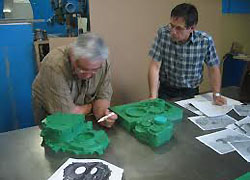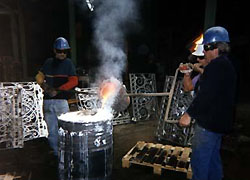The four most used processes for the casting of aluminun are: sand casting, die casting (gravity or pressure) and lost wax casting.
We are specialised in sand casting, since we desire to be as flexible as possible so as to provide the best possible service to our customers. It is also the best process for the production of our system of cast decorative, architectural and structural columns for conservatories, gazebos, verandas, patios as well as for interior decoration or renovation purposes.. We use it for the manufacture of the capitals, the bases and the decorative rings, whilst the shafts are extruded. Our columns are much lighter than columns in cast iron.
Cast aluminium is a much better material for producing decorative columns inspired from traditional elegance than cast iron or cast steel, since it is lighter and thus easier to manipumale and to install; it is nearly as load-bearing as cast iron.

The main advantages of sand casting are:
- Swiftness and reasonable cost for the setting-up
- Excellent precision/cost ratio
- Products are easily adapted if necessary
- A perfect process for small to medium-sized quantities
- A perfect process for prototyping
- A perfect process for the production of our proprietary system of bespoke columns.
But it is a relatively expensive process since it implies a high degree of highly skilled manpower. This explains partly the price of our elements for columns: it is a high-end product. It is made in Belgium, and it is belgian quality.
When it goes about large quantities, we subcontract the work to one of our partners specialized in die-casting.
The development of the models and of the moulds for our capitals, bases and decorative rings used for the assembly of our columns..
This crucial phase will often imply a close cooperation with the client.

This phase is really important because it is upon the way the aluminium flows into the mould until it is completely filled that will depend the mechanical properties of the part, and the amount of work necessary for its machine finishing. One has to take into account: the retraction of the liquid aluminium alloy during its cooling phase (approximately 1.5% in volume), the differences of temperature between various zones of the part, the de-moulding process...
As a matter of fact, one speaks here about fluid dynamics. Casters do that since ages without even knowing it.
One will have to determine where to locate the "dozzles" (reserves of liquid metal, that will fill the gaps left by the retraction), the cores and the core manufacturing tools...
Good software exist for the development of the moulds, the cores and the casting conduits. But professionals are unanimous to say that there is nothing like experience acquired through years of practice. The best is obviously to have both: experience, and mastering the software or other hi-tech tools. At Aludeclercq.be, we have more than 50 years of experience in the casting of aluminum alloys, and a good knowledge of the relevant software and other "state of the art" tools.
The moulds for sand casting
Everyone knows that building a sand castle with dry sand does not work well. Something has to be added to the sand, on the beach as well as in a foundry. We work with moulds that are made either in "green sand" (sand + water + clay) or in "chemical sand" (sand + resins + hardener). Both are easily recycled and re-used, without any risk for the environment.

The aluminium alloys
Many alloys exist, with various properties. These alloys were developed in function of the characteristics required for the casted parts, and in function of their usages. Aluminium is almost never used in its pure form. Alluminum is mixed with silicium, copper, magnesium, titanium, cobalt, etc. The quality of the alloy is measured before the casting, and noted in the "casting report".
In function of the needed characteristics, the casted parts will in some cases be case-hardened (to harden the surface of the part), or case-softened (to release the internal tensions in the metal).
Typical applications for sand casting
- prototyping in its broad sense (automotive or aeronautical industries)
- small or medium-sized series, with high technical requirements (weapons, racing cars parts, high speed railway transportation)
- art castings, machinery for the food processing or the textile industries, the transportation sector, public lighting, etc.
- any part of complex shape, submitted to high mechanical strains, such as engine blocks, carters for torque converters, boggies for high-speed trains, landing gears...
- and: our system of modular, bespoke and and cut to size columns
In brief, all applications where: lightness, good resistance to dynamical strain, weld-ability, a good thermal conductivity, etc. are required in various mixes, without necessarily looking towards mass-production.
It is not without reason that the engines and gearboxes of nearly all luxury cars are produced through aluminium sand-casting (much lighter than cast iron). See for instance this video on the Ferrari foundry.




